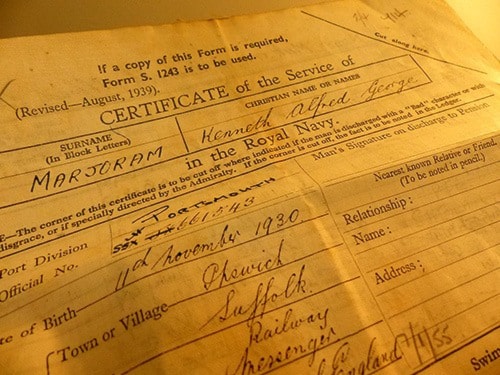When your birthday is Nov. 11 – Remembrance Day – you’re a naval veteran and you’re on the executive of the Cloverdale Legion, you make party plans for a different day.
Ken Marjoram was barely old enough to shave, living half a world away in England, when he joined the Royal Navy as a boy seaman.
A restless, rebellious lad of 15 from Ipswich, he’d tried his hand at boat building, painting, and had been employed as a railway messenger when he entered the gates at HMS Ganges, a land frigate.
It’s demanding training author Tom Robson has described as pushing boys to their limits to prepare their character and fitness to become members of the senior service and their readiness to join the navy.
 Marjoram says part of the routine involved scaling a 143-foot-tall training mast each morning, learning the art of climbing rigging while on dry land.
Marjoram says part of the routine involved scaling a 143-foot-tall training mast each morning, learning the art of climbing rigging while on dry land.
The Second World War had ended, but just barely. Born in 1930, he was just a young boy when the war began in September 1939.
His mother worked at the munitions factory because all the men – his father, who was in the air force, included – were away. There was a bomb shelter in the back yard.
“You had blackouts. Your curtains were drawn, so the aircraft didn’t see where you were. But they knew where we were anyhow,” he shrugs.
He was briefly evacuated along with other children from his city because the munitions factory was a target. But they weren’t away for long, he says, not elaborating.
Nor does he dwell on deprivations like going without the extras we take for granted, despite rationing for things like butter, tea and sugar.
“I don’t eat a lot of candy now, because I wasn’t used to it as a kid,” he allows.
When the war ended, there was still a demand for sailors and soldiers to patrol the world’s hot spots.
Marjoram’s first ship was the HMS Sheffield, a cruiser. He spent 12 months in the Caribbean. Then it was back to England for gunnery training at Portsmouth.
There was a demand for certified anti-aircraft gunners in the navy. And there was a demand for capable soccer players, it turned out. Every ship had a team, and Marjoram was a decent goal keeper. They played in every port, scuffing on gravel-covered fields.
There was no on-board physical fitness program in those days, so he devised his own, lifting weights and doing pull-ups.
After qualifying as a gunner, his next Naval posting was on patrol in the Suez Canal, where political and military tensions were rising.
Col. Nasser, Egypt’s military strongman, was determined to nationalize the canal – a shortcut for the world’s freight that was controlled by Great Britain and France.
“If it was nighttime, there were fishermen out on boats at night, and they wouldn’t run with any lights. If you came across one, you had carte blanche to fire on them.” Fortunately, most of the trouble was at the mouth of the canal at Port Said.
Marjoram recalls a region beset by skirmishes, tensions and even guerrilla raids.
Some memories stick out.
He remembers sailing through the Suez Canal at Port Said, where a friend who was in the Airborne was on the jetty, waiving as Marjoram’s vessel went through. “I knew it was him,” Marjoram smiles.
In Italy, they had to worry about mines being planted under the ship. If the crew saw bubbles forming on the surface of the water, they’d run a bomb detection wire underneath the vessel. If anything was found, divers were sent down to deactivate the bombs.
In Greece, there were bandits coming down from the mountains, raiding bases. “So they sent us in” prompting a joke from Marjoram to the officer in charge about the sailors being mistaken for mountain goats.
His crew came home for the coronation naval review of the young Queen Elizabeth II in 1953, only to be sent right back out to sea again.
He served with the Merchant Navy from 1955 to 1966. “It was like, a lot less B.S., more money,” he explains bluntly, in his Suffolk accent.
He worked on a succession of vessels, including a Shell Oil freighter that delivered petroleum to Israel and once spent an entire year on a stamp steamer, delivering cargo, to India, Sudan, Japan, and Vancouver before returning to England.
He came to Canada in 1968, when he married his late wife. They raised one daughter.
A member of Cloverdale Legion Branch 6 for 16 years, you’ll find him at the hall weekday mornings performing repairs and maintenance.
He turns 83 on Monday, when he’ll lead the veterans on parade to the Cenotaph at Surrey Museum Plaza and then back to the branch, where they’ll raise a glass.
Now a Canadian citizen, he returns to England every year for the annual reunion for the HMS Ganges, the naval training frigate.
“Last year, there was 400 [attendees],” he says. He plans to go back in April. “This year, it’s full again.”
He’s already booked his ticket.
See also: A Soldier's Road Home, April 3, 2013, featuring the story of Cloverdale-raised retired Cpl. John Lowe's inspiring efforts to bring awareness to the plight of soldiers coping with Operational Stress Injuries and PTSD.Follow the Cloverdale Reporter on  Twitter and
Twitter and ![]() Facebook.
Facebook.
